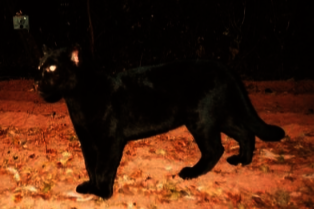By Manon Koningstein | Chief Marketing & Communications Officer
With our camera traps in the Atlantic Forest in Brazil we know for sure that different kinds of endangered animals are returning to the area.
For example the ´Potoo´ (Nyctibius griseus). This nocturnal bird feeds on insects during the night. During the day she looks like a tree trunk to avoid being seen, and it is therefore that the local names for the Potoo can be translated as ´the mother of the moon´ and ´ghost bird´.
The Potoo prefers to feed and rest on younger and more open forests where it can move around more easily, and can therefore be seen a lot in our tree plantings and naturally-regenerating forests.
Another animal that has recently been spotted by our camera traps in the "Santa Monica Reserve", surrounding the Morro do Diabo State Park, is the Black Jaguar (Panthera onca. Black jaguars belong to the same species as the "regular" jaguar. It is estimated that around 20% of the jaguars are black jaguars.
The jaguar is listed as near threatened by the IUCN and has become locally extinct and critically endangered in some areas and habitat loss and fragmentation are to blame. However, seeing them in the camera traps means that small sub-populations are surviving, giving us all the reason to remain optimistic and to continue, with your support, restoring forests in the Atlantic forest in Brazil and help more species return to their natural habitat.
Project reports on GlobalGiving are posted directly to globalgiving.org by Project Leaders as they are completed, generally every 3-4 months. To protect the integrity of these documents, GlobalGiving does not alter them; therefore you may find some language or formatting issues.
If you donate to this project or have donated to this project, you can receive an email when this project posts a report. You can also subscribe for reports without donating.
Support this important cause by creating a personalized fundraising page.
Start a Fundraiser